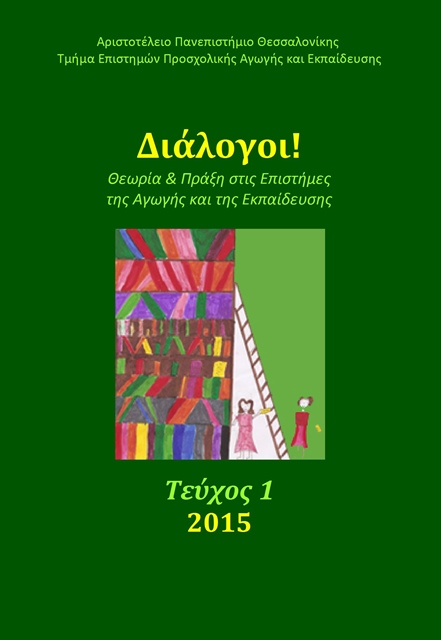Η διακρίβωση του αυτοπροσδιορισμού μαθητών πρωτοβάθμιας εκπαίδευσης σε επικινδυνότητα για μαθησιακές δυσκολίες: η συμβολή των γνωστικών και μεταγνωστικών ικανοτήτων και των ευκαιριών πλαισίου

Περίληψη
Εισαγωγή
Οι μαθητές σε επικινδυνότητα για μαθησιακές δυσκολίες διακρίνονται από περιορισμένες μεταγνωστικές δεξιότητες και αρνητικό αυτοσυναίσθημα, χαρακτηριστικά που επηρεάζουν αρνητικά την παρώθηση και τον αυτοπροσδιορισμό τους.
Στόχος της έρευνας
Η σκιαγράφηση του επιπέδου του αυτοπροσδιορισμού μαθητών πρωτοβάθμιας εκπαίδευσης σε επικινδυνότητα για μαθησιακές δυσκολίες, έτσι όπως αυτό αποτυπώνεται από τους ίδιους τους μαθητές και τις μητέρες τους.
Μέθοδοι
Το δείγμα της έρευνας αποτελούσαν 70 μαθητές της ΣΤ΄ τάξης δημοτικού και οι μητέρες τους. Τριανταεπτά μαθητές ήταν μαθητές τυπικής ανάπτυξης και 33 ήταν μαθητές σε επικινδυνότητα για μαθησιακές δυσκολίες, σύμφωνα με την ελληνική στάθμιση του κριτηρίου μαθησιακής επάρκειας Detroit, DTLA-4. Για τη συλλογή των δεδομένων χρησιμοποιήθηκε η κλίμακα αυτοπροσδιορισμού AIR Self-Determination Scale.
Αποτελέσματα
Οι μαθητές σε επικινδυνότητα για μαθησιακές δυσκολίες εκτίμησαν ότι είναι λιγότερο αυτοπροσδιορισμένοι από τους τυπικής ανάπτυξης συμμαθητές τους. Όλες οι μητέρες θεώρησαν ότι το επίπεδο αυτοπροσδιορισμού των παιδιών τους βρίσκεται σε υψηλότερο επίπεδο από αυτό που θεωρούν τα ίδια τα παιδιά τους. Όλοι οι μαθητές είχαν την άποψη ότι οι ευκαιρίες για την καλλιέργεια του αυτοπροσδιορισμού δίνονται περισσότερο στην οικογένεια παρά στο σχολείο, σε αντίθεση με τις μητέρες τους.
Συμπεράσματα
Απαιτείται συνεργασία σχολείου-οικογένειας προς την κατεύθυνση της διδασκαλίας μεταγνωστικών δεξιοτήτων και της ανάπτυξης κινήτρων προκειμένου να καλλιεργηθεί ο αυτοπροσδιορισμός των μαθητών.
Λεπτομέρειες άρθρου
- Πώς να δημιουργήσετε Αναφορές
-
Vouyoukas, K. (2016). Η διακρίβωση του αυτοπροσδιορισμού μαθητών πρωτοβάθμιας εκπαίδευσης σε επικινδυνότητα για μαθησιακές δυσκολίες: η συμβολή των γνωστικών και μεταγνωστικών ικανοτήτων και των ευκαιριών πλαισίου. Διάλογοι! Θεωρία και πράξη στις επιστήμες αγωγής και εκπαίδευσης, 1, 36–55. https://doi.org/10.12681/dial.1987
- Τεύχος
- Τόμ. 1 (2015)
- Ενότητα
- Ειδικό Θέμα

Αυτή η εργασία είναι αδειοδοτημένη υπό το CC Αναφορά Δημιουργού – Μη Εμπορική Χρήση – Παρόμοια Διανομή 4.0.
Οι συγγραφείς των άρθρων που δημοσιεύονται στο Διάλογοι! Θεωρία και Πράξη στις Επιστήμες Αγωγής και Εκπαίδευσης διατηρούν τα δικαιώματα πνευματικής ιδιοκτησίας επί των άρθρων τους, δίνοντας στο περιοδικό το δικαίωμα της πρώτης δημοσίευσης. Άρθρα που δημοσιεύονται στο Διάλογοι! Θεωρία και Πράξη στις Επιστήμες της Αγωγής και Εκπαίδευσης διατίθενται με άδεια Creative Commons 4.0 και σύμφωνα με την άδεια μπορούν να χρησιμοποιούνται ελεύθερα, με αναφορά στον/στη συγγραφέα και στην πρώτη δημοσίευση για μη κερδοσκοπικούς σκοπούς και με δικαίωμα τροποποίησης μόνον με παρόμοια διανομή (αν αναμείξετε, τροποποιήσετε, ή δημιουργήσετε πάνω στο υλικό, πρέπει να διανείμετε τις δικές σας συνεισφορές υπό την ίδια άδεια όπως και το πρωτότυπο).
To Τμήμα Επιστημών Προσχολικής Αγωγής και Εκπαίδευσης του Αριστοτέλειου Πανεπιστημίου Θεσσαλονίκης και το Εθνικό Κέντρο Τεκμηρίωσης διατηρούν το δικαίωμα να δημοσιεύουν, να αναπαραγάγουν, να παρουσιάζουν στο κοινό, να διανέμουν και να χρησιμοποιούν άρθρα που δημοσιεύονται στο Διάλογοι! Θεωρία και Πράξη στις Επιστήμες Αγωγής και Εκπαίδευσης σε οποιοδήποτε μέσο και μορφή είτε μεμονωμένα είτε ως μέρη συλλογικών έργων, για όλο το χρόνο διάρκειας προστασίας της πνευματικής ιδιοκτησίας και για όλες τις χώρες του κόσμου.
Αυτό περιλαμβάνει ενδεικτικά, και όχι αποκλειστικά, το δικαίωμα δημοσίευσης των άρθρων σε τεύχη του περιοδικού Διάλογοι! Θεωρία και Πράξη στις Επιστήμες Αγωγής και Εκπαίδευσης, αναπαραγωγής και διανομής μεμονωμένων αντιγράφων των άρθρων, αναπαραγωγής ολόκληρων των άρθρων σε άλλη έκδοση του Τμήματος Επιστημών Προσχολικής Αγωγής και Εκπαίδευσης του Αριστοτέλειου Πανεπιστημίου Θεσσαλονίκης και του Εθνικού Κέντρου Τεκμηρίωσης και αναπαραγωγής και διανομής των άρθρων ή περίληψης αυτών με χρήση πληροφορικού συστήματος αποθετηρίου.


